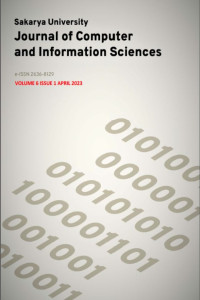Abstract
References
- [1] E. M., Soop, “Handbook Of Geostationary Orbits”, Kluwer Academic Publishers, Netherlands, 1994.
- [2] M. Richharia, “An Optimal Strategy for Tracking of Geosynchronous Satellites”. IETE Journal of Research. 30. 103-108. 10.1080/03772063.1984.11453249,1984
- [3] A. Pirhadi, M. Hosseini and M. Hakkak, “A novel implementation of GEO satellite step track subsystem”. Iranian Journal of Electrical and Computer Engineering (IJECE). 4. 71-76, 2005
- [4] S. Kawase, N. Kawaguchi, T. Tanaka and K. Tomita, "Optical Calibration of Geostationary Satellite Tracking Systems," IEEE Transactions on Aerospace and Electronic Systems, vol. AES-17, no. 2, pp. 167-172, March 1981, doi: 10.1109/TAES.1981.309142.
- [5] S. Kawase, "Radio interferometer for geosynchronous-satellite direction finding", IEEE Transactions on Aerospace and Electronic Systems, vol.43, no.2, pp.443-449, 2007.
- [6] D. Roddy, “Satellites Communications”, Mcgrow-Hill, 2001.
- [7] S.V. Devika, K. Karki, S. Kotamraju, K. Korada and M.Z.U. Rahman, “A new computation method for pointing accuracy of cassegrain antenna in satellite communication”, Journal of Theoretical and Applied Information Technology. 95. 3062-3074, 2017
- [8] İ. Oz, Ü.C. Yılmaz, “Determination of Coverage Oscillation for Inclined Communication Satellite”. Sakarya University Journal of Computer and Information Sciences (2020). 2. 973-983. DOI: 10.16984/saufenbilder.702190.
- [9] H. Yuanzhi and C. Ma. "Analysis of the Effect of Antenna Pointing Error Caused by Satellite Perturbation on Space Terahertz Communication" Applied Sciences 12, no. 21: 10772. https://doi.org/10.3390/app122110772, 2022
- [10] Z. Peng, R. Bin, W. Youping, F. Yongqiang, J. Bo and Z. Weibo, "The effect of orbital elements on GEO satellite communication quality," 2012 IEEE Aerospace Conference, Big Sky, MT, USA, pp. 1-6, doi: 10.1109/AERO.2012.6187120, 2012
- [11] S. Mrak, U. Kuhar and A. Vilhar, "Low-Cost system design for tracking satellites in geosynchronous orbit," 2015 9th European Conference on Antennas and Propagation (EuCAP), Lisbon, Portugal, 2015, pp. 1-5.
Abstract
Geostationary Satellites (GEO) are being used commonly in communication market. The service providers uplink or downlink the signal by using their dedicated antennas (whether with or without tracking capability) to the GEO satellite. The satellite down-converts and amplifies the signal before sending back to the end users on Earth. Normally, the user set and adjust the uplink antenna to follow the GEO satellite movement as much as possible. As soon as there is no reduction in the link budget, this pointing assumed to be successful. On the other hand, the input power of the satellite, together with satellite longitude vs latitude, can give reasonable ideas about the accuracy of the ground antenna pointing. In the study, ground station pointing performance is shown with two different cases. One with tracking and one without tracking capability.
Keywords
References
- [1] E. M., Soop, “Handbook Of Geostationary Orbits”, Kluwer Academic Publishers, Netherlands, 1994.
- [2] M. Richharia, “An Optimal Strategy for Tracking of Geosynchronous Satellites”. IETE Journal of Research. 30. 103-108. 10.1080/03772063.1984.11453249,1984
- [3] A. Pirhadi, M. Hosseini and M. Hakkak, “A novel implementation of GEO satellite step track subsystem”. Iranian Journal of Electrical and Computer Engineering (IJECE). 4. 71-76, 2005
- [4] S. Kawase, N. Kawaguchi, T. Tanaka and K. Tomita, "Optical Calibration of Geostationary Satellite Tracking Systems," IEEE Transactions on Aerospace and Electronic Systems, vol. AES-17, no. 2, pp. 167-172, March 1981, doi: 10.1109/TAES.1981.309142.
- [5] S. Kawase, "Radio interferometer for geosynchronous-satellite direction finding", IEEE Transactions on Aerospace and Electronic Systems, vol.43, no.2, pp.443-449, 2007.
- [6] D. Roddy, “Satellites Communications”, Mcgrow-Hill, 2001.
- [7] S.V. Devika, K. Karki, S. Kotamraju, K. Korada and M.Z.U. Rahman, “A new computation method for pointing accuracy of cassegrain antenna in satellite communication”, Journal of Theoretical and Applied Information Technology. 95. 3062-3074, 2017
- [8] İ. Oz, Ü.C. Yılmaz, “Determination of Coverage Oscillation for Inclined Communication Satellite”. Sakarya University Journal of Computer and Information Sciences (2020). 2. 973-983. DOI: 10.16984/saufenbilder.702190.
- [9] H. Yuanzhi and C. Ma. "Analysis of the Effect of Antenna Pointing Error Caused by Satellite Perturbation on Space Terahertz Communication" Applied Sciences 12, no. 21: 10772. https://doi.org/10.3390/app122110772, 2022
- [10] Z. Peng, R. Bin, W. Youping, F. Yongqiang, J. Bo and Z. Weibo, "The effect of orbital elements on GEO satellite communication quality," 2012 IEEE Aerospace Conference, Big Sky, MT, USA, pp. 1-6, doi: 10.1109/AERO.2012.6187120, 2012
- [11] S. Mrak, U. Kuhar and A. Vilhar, "Low-Cost system design for tracking satellites in geosynchronous orbit," 2015 9th European Conference on Antennas and Propagation (EuCAP), Lisbon, Portugal, 2015, pp. 1-5.
Details
| Primary Language | English |
|---|---|
| Subjects | Electrical Engineering |
| Journal Section | Articles |
| Authors | |
| Early Pub Date | April 28, 2023 |
| Publication Date | April 30, 2023 |
| Submission Date | November 27, 2022 |
| Acceptance Date | March 9, 2023 |
| Published in Issue | Year 2023Volume: 6 Issue: 1 |
Cite
Cited By
Estimation of Uplink Channels for Multiple Users Using Tensor Modeling in RIS-Aided MISO Communication
Sakarya University Journal of Computer and Information Sciences
https://doi.org/10.35377/saucis...1356872
The papers in this journal are licensed under a Creative Commons Attribution-NonCommercial 4.0 International License


